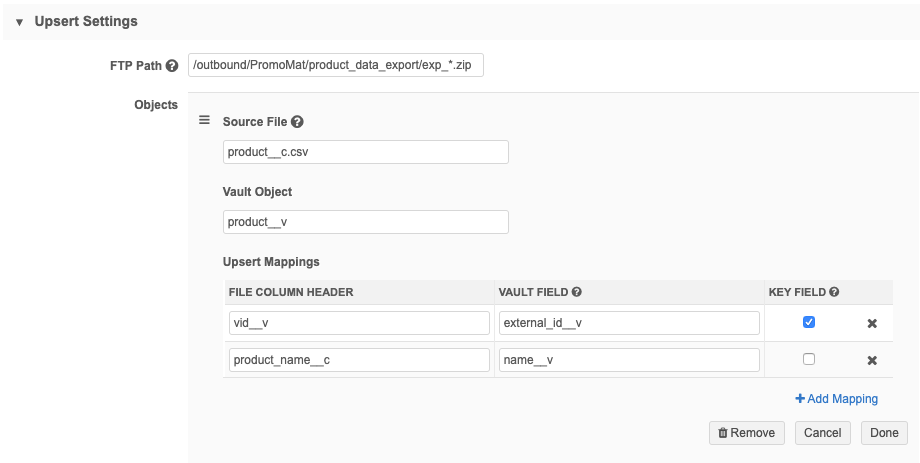Upserting data to Vault
Push object data from Network's FTP server to your Veeva Vault application using a Veeva Connector.
Supported objects
-
Veeva standard objects
-
Custom objects
Prerequisites
To upsert data to Vault, the following task must be completed:
- Add Vault credentials - The credentials are used to connect Network to Veeva Vault.
Create a connector to Veeva Vault
Create a Veeva Connector so you can push object data to Vault.
- In the Admin console, click System Interfaces > Veeva Connector.
- Click Add Veeva Connector.
-
In the Add Veeva Connector dialog, expand the lists to select the following values:
- Connector Type - Vault
- Operation - Upsert
Click Next. The new Vault connector page displays.
-
Details section- Define the following information:
-
Connector Enabled - Choose Yes.
When the connector is enabled, you can test the connection between Network and the Vault org and you can push data to Vault.
- Name - Type a meaningful name for the connector.
- System - Choose a system. If you do not have a system configured for Vault, create one by navigating to System Interfaces >Systems.
-
-
Connection Settings section - Expand the Vault Credential list and select the credential.
Click Test Connection to ensure that the credentials are valid.
A panel displays to provide information about the environment the credential is connecting to and to indicate if the credentials are valid or if there were issues connecting to the Vault server (not credential-related). Warnings display if you are potentially connecting to the wrong environment.
-
Upsert Settings section- Define the Network FTP path that will store the .csv files that will be extracted from Network and pushed to Vault. The path can include subdirectories. Wildcard characters are also supported.
The FTP path can specify a directory, path, or a specific .zip file name. Directory paths must end in a forward slash (/). Wildcard characters are supported for.zip file names. If you specify a path and there are multiple files, the most recent file will be used during the job.
FTP path examples
Type Path Description Wildcard .zip file outbound/VaultGrants/vault_grants_export/exp*.zip The Veeva Connector will find the most recent .zip file in the vault_grants_export folder that starts with exp. Target subscription outbound/VaultGrants/vault_grants_export/ Specify the directory path of a scheduled target subscription. Tip: To regularly upsert data from report results, specify the FTP path for the saved report results. The upsert connector will find the latest results in the path, including any subfolders the .zip file might be in. For more information, see Upserting data from reports.
For information about accessing the files in your Network file system, see File Explorer.
-
Objects - Specify the objects that will be pushed to Vault.
For each object, define the following details:
- Source File - The name of the file. If more than one file exists in the FTP folder, the latest file will be read.
- Vault Object - The Vault object name; for example, product__v.
-
Field Mappings - Map a lookup to the Vault fields so you can load sub-objects and relationship objects from Network.
Lookups are references to other objects. In Network, sub-objects and relationship objects contain VID references to other objects. In Vault, Parent Object and Object fields are references to other objects (for example, applicant__c, application__c).
- File Column Header - The Network field name. For example, entity_vid__v.
- Vault Field - The Vault field name. For example, application__c.application_number__v.
-
Key Field - The field that you want to use for an exact match to the Vault data. The Key Field should be either the Vault ID field or a field configured where values must be unique.

To include another mapping for the same object, click + Add Mapping.
To include more objects, click + Add Object. You can order which object is loaded first using the handle
 beside Source File.
beside Source File. -
Job Trigger Configuration section - Define the schedule for the job and any subsequent actions that will start when this job finishes.
Job Schedule - Run the job manually or on a scheduled basis. If you select Manual, the job only runs when you click the Start Job button on the configuration page.
Job Triggers - Trigger other actions to start after a job runs.
Available triggers:
- Send email - Specify users that should be notified for successful and unsuccessful job outcomes.
- Start a job - Start a subsequent job when this job successfully completes. Use trigger a target subscription to load the Network data into Vault. when the Vault push job completes.
For more information, see Subscription job triggers.
- Save your changes.
The Veeva Vault integration is complete. When the upsert job runs, Network will connect to Vault to push the object data from Network's FTP server.
About empty files
Target subscriptions can generate empty .csv files when they are set to delta. The Vault connector will skip loading a file if it is empty.
Job details
On the Job Details page, the Upsert Summary section displays any files that were skipped. The Records Processed and Records Failed columns display a zero (0) count.

Configuration management
Administrators can export a Veeva Connector to a target environment. Vault upsert configurations can be exported but credentials and schedules cannot; schedules and credentials must be defined on the target instance.
For more information, see Exporting configurations.